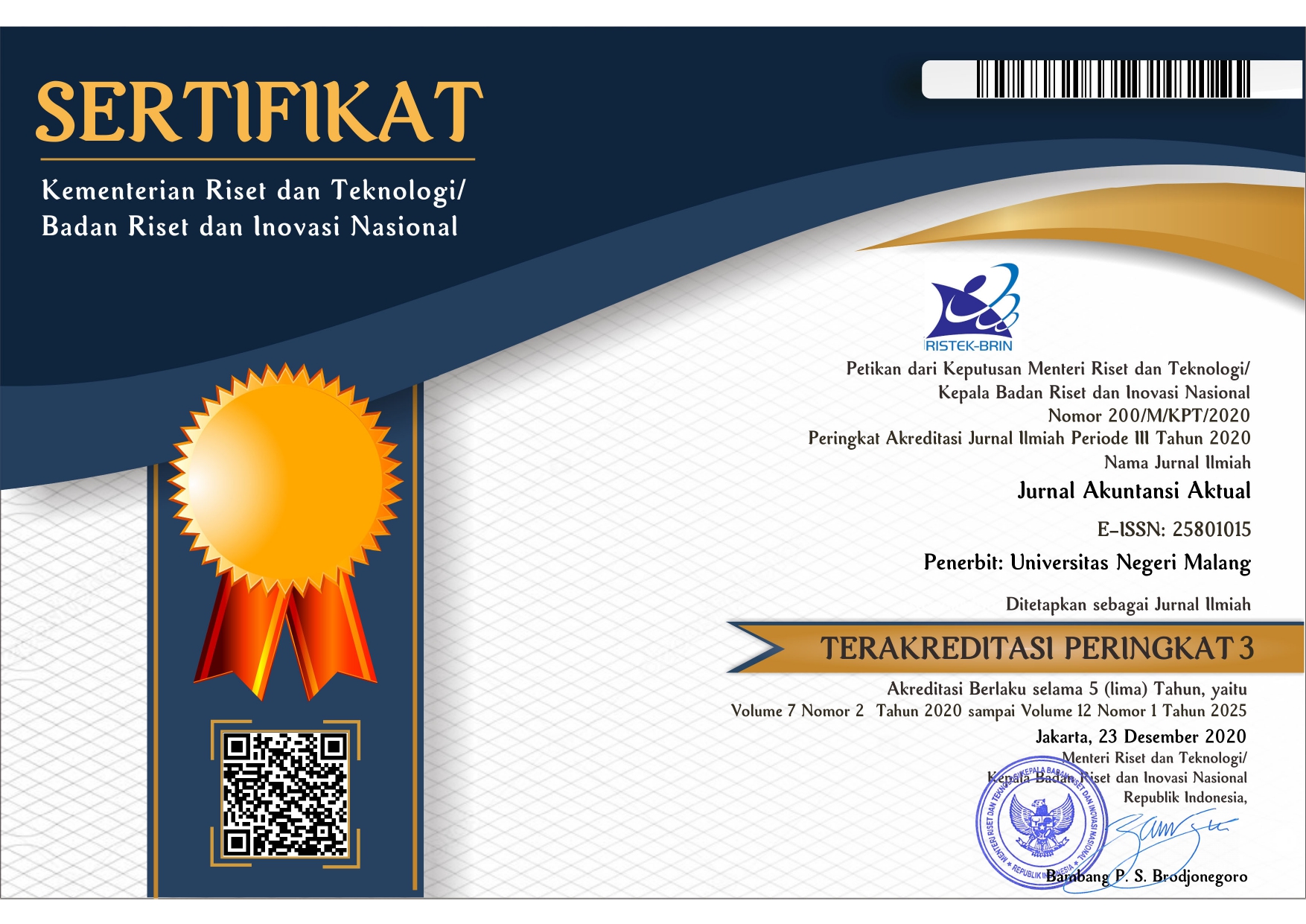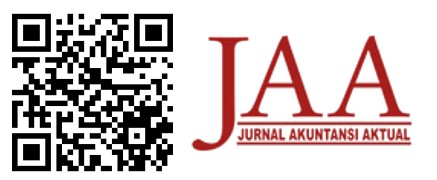DETERMINAN KEPUASAN SISTEM PERBENDAHARAAN DAN ANGGARAN NEGARA (STUDI PADA DIREKTORAT JENDERAL PERBENDAHARAAN)
Abstract
One of e-government implementation in the state financial management is using of Treasury and State Budget System (SPAN) application. SPAN user satisfaction is one of the indicators that is used to measure implementation success and users acceptance. The purpose of this study is to examine the determinants of SPAN user satisfaction consisting of information quality, system quality, perceived ease of use, perceived usefulness, attitudes, intention to use and uses from Technology Acceptance Model (TAM) and DeLone and McLean model, combined with computer self efficacy and social influences. The research was conducted at Directorate General of Treasury (DJPB), Ministry of Finance, Republic of Indonesia. The study used questionnaires distributed to 432 SPAN user respondents. There were 125 questionnaires returned and successfully processed. The result of analysis with partial least square successfully showed that the whole variable is determinant of SPAN user satisfaction. The implications of this research can support the development of SPAN with attention to user satisfaction.
Keywords
Full Text:
PDFReferences
Agarwal, R. dan Prasad, J. (1999). Are Individual Differences Germane to the Acceptance of New Information Technologies? Decision Sciences, 30(2), 361-391.
Ajzen, I. (1991). The Theory of Planned Behavior. Organizational Behavior and Human Decision Processes, 50(2), 179-211.
Al-Haderi, S. M. (2013). The Effect of Self-Efficacy in the Acceptance of Information Technology in the Public Sector. International Journal of Business and Social Science, 4(9), 188-198.
Bajaj, A., dan Nidumolu, S. R. (1998). A Feedback Model to Understand Information System Usage. Information and Management, 33, 213-224.
Bandura, A., dan Cervone, D. (1983). Self Evaluative and Self-Efficacy Mechanism Governing the Motivation Effect of Goal Systems. Journal of Personality and Social Psicology, 45(5), 1017-1028.
Brown, S. A., Massey, A. P., Montoya-Weiss, M. M., dan Burkman, J. R. (2002). Do I Really Have to? User Acceptance of Mandated Technology. European Journal of Information Systems, 11, 283-295.
Chau, P. (1996). An Empirical Investigation on Factors Affecting the Acceptance of CASE by Systems Developers . Information and Management, 30, 269-280.
Chau, P. Y. K., dan Hu, P. J. (2002). Examining a Model of Information Technology Acceptance by Individual Professionals: An Exploratory Study. Journal of Management Information Systems, 18(4), 191-230.
Chen, M. Y., Chang, F. M. T., Chen, C. C., Huang, M. J., dan Chen, J. W. (2012). Why do Individuals Use e-Portfolios. Educational Technology & Society, 15 (4), 114-125.
Cheong, J. H., dan Park, M. C. (2005). Mobile Internet Acceptance in Korea. Internet Research, 15 (2), 125-140.
Chiu, C. M., Chiu, C. S., dan Chang, H. C. (2007). Examining the Integrated Influence of Fairness and Quality on Learners’ Satisfaction and Webbased Learning Continuance Intention. Information Systems Journal, 17(3), 271-287.
Compeau, D. R., dan Higgins, C. A. (1995). Computer Self-Efficacy: Development of a Measure and Initial Test. MIS Quarterly, 19(2), 189-211.
Dalcher, I., dan Shine, J. (2003). Extending the New Technology Acceptance Model to Measure the End User Information Systems Satisfaction in a Mandatory Environment: A Bank's Treasury. Technology Analysis & Strategic Management, 15(4), 441-455.
Davis, F. D. (1989). Perceived Usefulness, Perceived Ease of Use, and User Acceptance of Information Technologies. MIS Quarterly, 13 (3), 319-340.
Davis, F. D., Bagozzi, R., dan Warshaw, P. R. (1989). User Acceptance of Computer Technology: A Comparison of Two Theoretical Models. Management Science, 35 (8), 982-1003.
DeLone, W. H., dan McLean, E. R. (1992). Information Systems Success: The Quest for the Dependent Variable. Information Systems Research, 3(1), 60-95.
DeLone, W. H., dan McLean, E. R. (2003). The DeLone and McLean Model of Information Systems Success: A Ten-Year Update. Journal of Management Information Systems,19(4), 9-30.
Dishaw, M. T., dan Strong, D. M. (1999). Extending the Technology Acceptance Model with Task-Technology Fit Constructs. Information and Management, 36, 9-21.
Eggers, W. D., dan Joel, B. (2015). The Journey to Government’s Digital Transformation. Deloitte University Press.
Fishbein, M., dan Ajzen, I. (1975). Belief, Attitude, Intention, and Behavior: An Introduction to Theory and Research. MA: Addison-Wesley Reading.
Gibson, J. L., Ivancevich, J. M., Donnelly Jr, J. H., dan Konopaske, R. (2009). Organization Behavior Structure Processes. Fourteenth Edition. New York: McGraw-Hill.
Goodhue, D. L., dan Thompson, R. L. (1995). Task-Technology Fit and Individual Performance. MIS Quarterly, 19(2), 213-236.
Guimaraes, T., Yoon, Y., dan Clevenson, A. (1996). Factors Important to Expert System Success: A Field Test. Information and Management, 30(3), 119-130.
Halawi, L. A., McCarthy, R. V., dan Aronson, J. E. (2007). An Empirical Investigation of Knowledge-Management Systems Success. The Journal of Computer Information Systems, 48(2), 121-135.
Handayani, R. (2005). Analisis Faktor-faktor yang Mempengaruhi Minat Pemanfaatan Sistem Informasi dan Penggunaan Sistem Informasi. Tesis. Semarang, Indonesia: Universitas Diponegoro.
Hartwick, J., dan Barki, H. (1994 ). Explaining the Role of User Participation in Information System Use. Management Science, 40(4), 440-465.
Hassn, A. H., Ismail, A., Borhan, M. N., dan Syamsunur, D. (2016). The Impact of Intelligent Transport System Quality: Driver Acceptance Perspective. International Journal of Technology, 4, 553-561.
Hu, P. J., Chau, P. Y. K., Sheng, O. R. L., dan Tam, K. Y. (1999). Examining the Technology Acceptance Model Using Physician Acceptance of Telemedicine Technology. Journal of Management Information Systems, 16(2), 91-112.
Hurst, K. R. (2010). Technology Acceptance in a Mandatory Technology-Based Learning Environment. Disertasi. Florida, Amerika Serikat: The University of West Florida.
Igbaria, M., Zinatelli, N., Cragg, P., dan Cavaye, A. L. M. (1997). Personal Computing Acceptance Factors in Small Firms: A Structural Equation Model. MIS Quarterly 21(3), 279-305.
Ives, B., Olson, M. H., dan Baroudi, J. J. (1983). The Measurement of User Information Satisfaction. Communications of the ACM, 26(10), 785-793.
Jackson, C. M., Chow, S., dan Leitch, R. A. (1997). Toward an Understanding of the Behavioral Intention to Use an Snformation System. Decision Sciences 28(2), 357-389.
Karahanna, E., Straub, D. W., dan Chervany, N. L. (1999). Information Technology Adoption Across Time: A Cross-Sectional Comparison of Pre-Adoption and Post-Adoption Beliefs. MIS Quarterly, 23(2), 183-213.
Koh, C. E., Prybutok, V. R., Ryan, S. D., dan Wu, Y. (2010). A Modelfor Mandatory Use of Sofware Technologies : An Integrative Approach by Applying Multiple Levels of Abstraction of Information Science. Informing Science: the International Journal of an Emerging Transdiscipline, 13.
Lederer, L., Maupin, D., Sena, M., dan Zhuang, Y. (2000). The Technology Acceptance Model and the World Wide Web. Decission Support Systems, 29, 269-282.
Liao, Z., dan Cheung, M. (2001). Internet-Based E-Shopping and Consumer Attitudes: An Empirical Study. Information & Management, 38, 299-306.
Livari, J. (2005). An Empirical Test of the DeLone -McLean Model of Information System Success. Database for Advances in Information Systems, 36(2), 8-27.
Maier, R. (2007). Knowledge Management Systems Information and Communication Technologies for Knowledge Management. Third Edition . Heidelberg : Springer.
Malik, B. H., Suqin, C., Qamar, S., dan Mattiullah, B. (2016). Examining Success of Land Record Information Systems (LRMIS) in Pakistan: Validating an Incorporated IS Success Model. European Scientific Journal,12(2), 258-289.
McGill, T., Hobbs, V., dan Klobas, J. (2003). User-Developed Applications and Information Systems Success: A Test of DeLone and McLean’s Model . Information Resources Management Journal, 16(1), 24-45.
Ndou, V. (2004). E-government for Developing Countries: Opportunities and Challenges. The Electronic Journal on Information Systems in Developing Countries, 18(1), 1-24.
Ong, C. S., dan Lai, J. Y. (2006). Gender Differences in Perceptions and Relationships Among Dominants of E-Learning Acceptance. Computers in Human Behavior, 22(5), 816-829.
Rahadian, F., Djunaedi, A., dan Suwastono, A. (2015). Analisis Penerimaan dan Kepuasan Pengguna Terhadap Aplikasi E-Purchasing dengan Model Integrasi. Seminar Nasional Teknologi Informasi dan Multimedia, 13-18.
Rai, A., Lang, S. S., dan Welker, R. B. (2002). Assessing the Validity of IS Success Models: An Empirical Test and Theoretical Analysis. Information Systems Research, 13(1), 5–69.
Seddon, P. B. (1997). A Respecification and Extension of the DeLone and McLean Model of IS Success. Information Systems Research, 8(3), 240-253.
Seddon, P. B., dan Kiew, M. (1996). A Partial Test and Development of DeLone and McLean’s Model of Is Success. Australian Journal of Information system, 4(2), 90-109.
Sekaran, U., dan Bougie, R. 2010. Research Methods for Bussiness-A Skill Building Approach. West Susssex, United Kingdom: John Wiley and Sons.
Taylor, S., dan Todd, P. (1995). Understanding Information Technology Usage: A Test of Competing Models. Information Systems Research, 6(2), 144-176.
Thong, J. Y. L., Hong, S. J. dan Tam, K. Y. (2006). The Effects of Post-Adoption Beliefs on the Expectation-Confirmation Model for Information Technology Continuance. International Journal of Human Computer Studies, 64(9), 799-810.
Vaezy, R. (2013). User Satisfaction with Information System: A Comphrehensive Model of Attribut Satisfaction. Disertasi. Houston, Amerika Serikat: University of Houston.
Venkatesh, V., dan Bala, H. (2008). Technology Acceptance Model 3 and a Research Agenda on Interventions. Decision Sciences, 39(2), 273-315.
Venkatesh, V., dan Davis, F. D. (2000). A Theoretical Extension of the Technology Acceptance Model: Four Longitudinal Field Studies. Management Science, 46(2), 186-204.
Venkatesh, V., Morris, M. G., Davis, G. B., dan Davis, F. D. (2003). User Acceptance of Information Technology: Toward a Unified View. MIS Quarterly, 27, 425-478.
Wahyudi, H. D. (2011). Analisis Sikap dan Niat Menggunakan Mini Laptop: Studi Pengembangan Model Penerimaan Teknologi. Jurnal Ekonomi Bisnis, 16(1), 44-52.
Wixom, B. H., dan Todd, P. A. (2005). A theoretical integration of user satisfaction and technology acceptance. Information Systems Research, 16(1), 85-102.
Wu, M. C. (2013). A Study on University Students’ Intention to Use the Digital Museum of Sports Literature. The Journal of International Management Studies, 8(2), 7-30.
Xu, J. D., Benbasat, I., dan Cenfetelli, R. T. (2013). Integrating Service Quality with System and Iinformation Quality: An Empirical Test in the E-Service Context. Mis Quarterly, 37(3), 777-794.
DOI: http://dx.doi.org/10.17977/um004v5i22018p108
Refbacks
- There are currently no refbacks.

This work is licensed under a Creative Commons Attribution-ShareAlike 4.0 International License.
Jurnal Akuntansi Aktual is indexed by:















